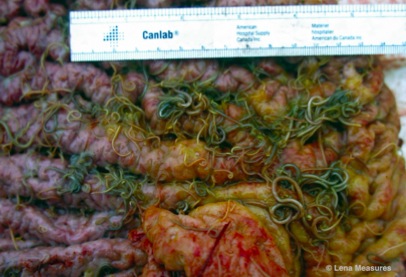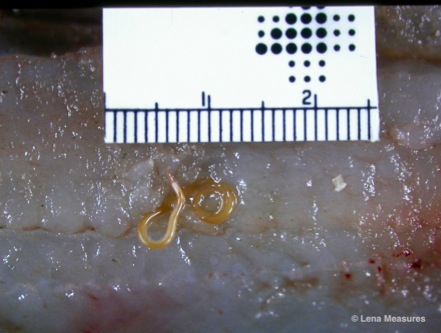Pseudoterranova spp.
Contributor: Lena Measures
Biology: Pseudoterranova spp. are roundworms or nematodes that parasitize pinnipeds (seals and sea lions). At least 8 species have been described, two of which occur in small whales.

Figure 1. Photo of Pseudoterranova decipiens in grey seal stomach.
Life cycle: The most common species, Pseudoterranova decipiens (more commonly called sealworm), reproduces in the stomach of seals such as grey or harbour seals (Figure 1). Female worms produce eggs (Fig. 2A) which enter the sea with the faeces of the seal. A period of development is required in the sea before larvae hatch from eggs. These larvae (Fig. 2B) are then eaten by a first intermediate host (Fig. 2C) which is a small crustacean such as a benthic copepod. Infected copepods are subsequently eaten by larger second intermediate hosts (Fig. 2D) which are also benthic invertebrates such as polychaetes, amphipods or amphipods. These invertebrates are themselves eaten by a small fish transport host (Fig. 2E) such as smelt, plaice, and sculpins. Small infected fish can in turn be eaten by large predatory fish (Fig. 2F) such as Atlantic cod, monkfish, sea raven and eelpout, which accumulate large numbers of sealworm larvae. Finally the life cycle is completed when the definitive or final host (Fig. 2G) such as a grey seal eats infected fish or, rarely, infected invertebrates.
LC Pseudoterranova
Figure 2. Life cycle of Pseudoterranova decipiens.
Transmission: Larval stages in fish are large (up to 60 mm long), pale red or brown in color and are usually found in the flesh or muscle (Figure 3). They may also be found on the viscera or free in the abdominal cavity of fish. Because they are large (Figure 4) and easily visible sealworm is an esthetic problem for the fishing industry which removes them at great cost. Unlike Anisakis, larval Pseudoterranova, are often seen by the consumer depending on the thickness of fish fillets and consumption is avoided.

Figure 3. Larval Pseudoterranova decipiens in the muscle of Atlantic cod.

Figure 4. Larval Pseudoterranova decipiens removed from Atlantic cod.
Prevalence: Pseudoterranova decipiens is reported in a wide variety of marine fish, and seals mostly in the northern hemisphere. In Canada sealworm is found in commercially important fish such as Atlantic cod, monkfish, sea raven, eelpout smelt, plaice, sculpins as well as American plaice and other flatfish species, cusk, haddock, hake, ocean pout, tomcod, etc. Prevalence is greatest in large benthic fish such as cod which may be infected with dozens of larvae.
Susceptible populations: Humans and other non-definitive hosts are accidentally infected by ingesting infected fish. As Pseudoterranova spp. do not mature and reproduce in humans or other non-definitive hosts they may be considered as dead-end hosts even though they are susceptible to infection. Infection with sealworm is called pseudoterranovosis. Infections are less common than anisakiosis worldwide but seem to be more common in North America and in northern Japan due to large seal populations. To date one case of pseudoterranovosis has been reported in Canada.
Symptoms: Many human cases of pseudoterranovosis likely go unreported, and many worms die or are expectorated without causing any symptoms or clinical signs. Clinical infections are usually suspected based on symptoms, clinical presentation, and history of recent consumption of improperly prepared seafood. Symptoms in acute cases of pseudoterranovosis, which generally involve the stomach, include intense epigastric pain, nausea and vomiting within 5 hours of consuming infected fish or squid. Frequently, a tingling sensation in the throat is reported prior to a worm being expectorated.
Treatment: In clinical cases of gastric pseudoterranovosis, infections may be diagnosed using gastroendoscopy whereby a fiberscopic tube equipped with a small camera and forceps, is passed through the mouth into the stomach to observe the surface of the mucosa. Using fine biopsy forceps, worms can then be removed.
Control measures: Sealworm is remarkably resistant to various environmental conditions. In fish flesh it can survive cold smoking up to 40°C, insufficient marination or salting and freezing temperatures down to -20°C for 4 to 5 days. Deep-freezing of fish (at least 24 hours at -30°C) and cooking (at least 5 minutes at 60°C) will kill larvae. Fish fillets may also be sliced thinly and examined with a strong light to visualize any worms for removal.